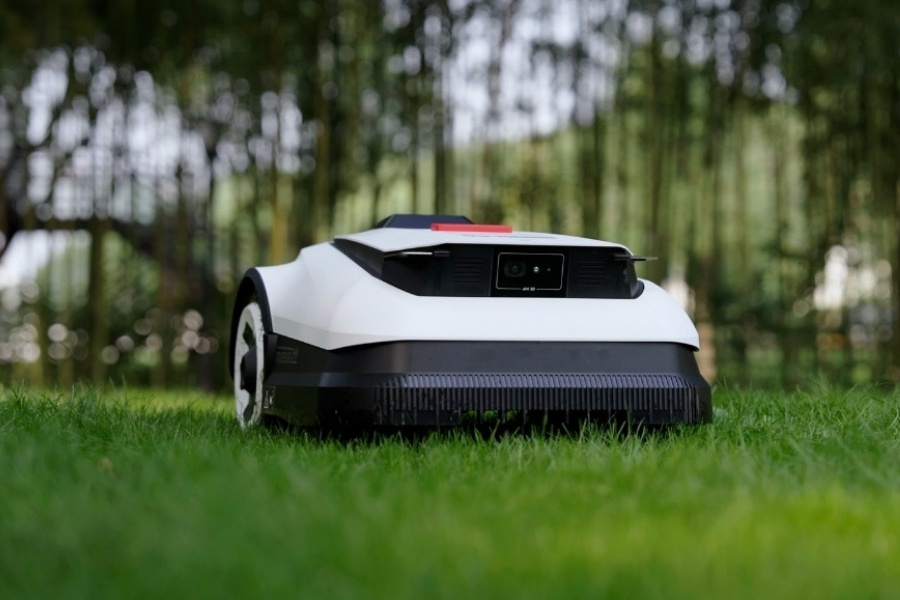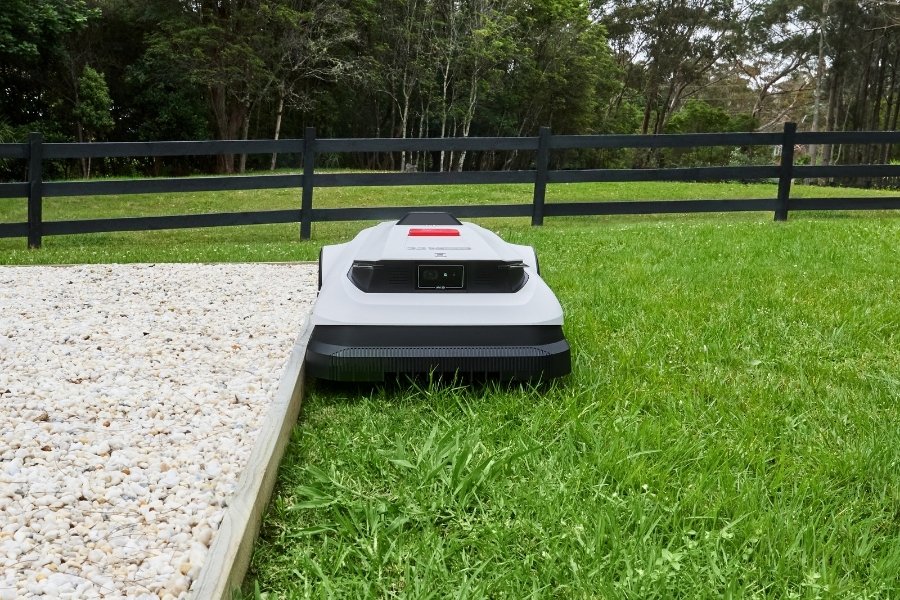Advantages and Disadvantages of Robot Lawn Mowers
2025-07-02

Automation has been a popular topic, and lawn mowers are no exception. In North America, the robotic lawn mower market is projected to grow from US$1.28 billion in 2025 to US$2.02 billion by 2034, with many people upgrading to robotic models to save time and improve lawn health. After all, when compared to traditional models, these convenient mowers require much simpler maintenance, and remote control makes operation easier. However, as with any product, it’s important to weigh the pros and cons of a robot lawn mower before deciding on one.
What Is a Robot Lawn Mower?
A robot lawn mower is an automated device that cuts grass without requiring human effort. Equipped with multiple sensors, cameras, LiDAR, or GPS, it navigates your yard while dodging obstacles and trimming grass with precision. Through the app, you can schedule and adjust settings from your phone, drastically save time and effort spent on lawn care.
What Are the Pros of Robot Mowers?
Robot lawn mowers not only save time with automated operation and reduce long-term costs, but they also promote lusher lawns through frequent mulching. Powered by batteries, they cut emissions and run quietly in peaceful neighborhoods. Plus, their advanced features keep them safe around pets and kids, and their compact design is great for storage.
1. Automated Convenience
Robot mowers reduce labor work by automating grass cutting. You can easily customize cutting schedules, heights, and no-go zones from the app, like the ECOVACS HOME app. That means you can trust the machine to care for your garden while you go to work, relax, or even travel.
2. Navigation & Obstacle Avoidance
Many gardens aren’t just flat or open, so advanced navigation helps map and avoid obstacles such as trees, furniture, or small animals. For example, the GOAT A2500 RTK features LiDAR-Enhanced RTK Technology (LELS), connecting to over 40 satellites to achieve 0.79-inch precision even in shaded areas.
Its TruEdge Consistent Edge Mowing allows the mower to detect edges. For passable boundaries, the device can cross and cut, while for unpassable edges, it adapts by keeping a close-to-edge distance of up to 1.97 inches.
3. Quiet Operation
Unlike traditional mowers that produce loud noises, robotic mowers like the GOAT O1000 RTK operate quietly at 57 dBA, softer than a normal conversation. Hence, you can schedule mowing to fit your lifestyle, even in early mornings or evenings, without worrying about disturbing neighbors.
4. Eco-Friendly
When comparing traditional models like ride-on mowers to robot mowers, gas-powered models emit harmful pollutants like carbon dioxide, which contribute to air pollution and climate change. Conversely, smart mowers are battery-powered and produce zero emissions.
5. Safety Features
Built-in safety features like lift sensors instantly stop the blades from rotating if the mower is lifted or tilted. GOAT mowers further come with AIVI 3D Obstacle Avoidance, which identifies and keeps a safety gap from over 200 types of obstacles while limiting grass left around.
6. Easy Storage
As opposed to the bulky design of traditional mowers, robot mowers for small lawns have a compact and lightweight build that is easy to store in garages or sheds. Premium models like GOAT mowers are IPX6 waterproof, so you can conveniently tuck them away in an outdoor area.
7. Lawn Health
Robot mowers mulch grass as they cut, producing finely chopped clippings that nourish the soil as natural fertilizer, promoting healthier, thicker lawns. These mowers run on preset schedules, as opposed to traditional mowers that require manual effort, and sometimes, you can feel lazy and skip the day.
8. Less Maintenance & Cost
Compared to previous models, auto mowers are relatively low-maintenance; no fuel, oil changes, or complex repairs, leading to potential long-term savings. Waterproof models like GOAT require a rinse every 1-2 weeks. GOAT models also cut off boundary wire installation, saving you from replacing it.
What Are the Cons of Robot Mowers?
Despite their benefits, robot lawn mowers have drawbacks, including higher upfront costs and theft risks. They may also struggle with overgrown grass or complex terrains, especially when there are stairs and steep slopes, while battery life can limit the lawn size they cover. Although upkeep is minimal, you still need to regularly clean and replace worn parts.

1. Upfront Investment
Robotic lawn mowers typically come with a higher price tag, with entry-level models starting at US$500 and premium models costing US$2,000 or more. However, they are worth the investment for the convenience and customization they offer. In the long run, they can further save you on fuel bills, oil changes, and hiring a gardener.
2. Regular Maintenance Needs
Although smart mowers require less maintenance than old models, they still need occasional upkeep, including cleaning the blades, wheels, and exterior. Models with a waterproof design, like the GOAT mowers, make maintenance as fast as a rinse.
3. Physical Limitations
Auto mowers can struggle with stairs, tight corners, or elevated surfaces. Advanced models like the GOAT A2500 RTK supports slope climbing up to 27° and barrier-crossing up to 1.75 inches. For narrow paths, the GOAT O1000 RTK’s ultraslim design can pass through spaces as tight as 2.3 feet1.
4. Not Suitable for Overgrown, Unkempt Lawns
Robot lawn mowers aren’t designed to handle overgrown lawns, and tall grass or weeds can quickly clog the blades. It's best to use smart mowers like the GOAT A2500 RTK for regular maintenance only, and you can adjust the cutting height from 1.2 to 3.6 inches via the app for a clean, even cut.
5. Limited Lawn Size
While models such as the GOAT A2500 RTK are capable of handling lawns up to ½ acre, covering up to 4,305 square feet per hour2 at speeds of 2.3 feet per second, large yards in areas like Alaska and Maine can well exceed an acre. Pushing a mower over its coverage limit may cause it to lose signal and stop working.
6. Theft Risk
Since well-maintained smart mowers have good resale value, they can become attractive targets for theft. Their portable design, while convenient, also makes them easy to steal. Common anti-theft features include PIN code protection and alarm systems, but this remains a concern for homeowners.
7. Battery Life
Batteries make smart mowers eco-friendly, but they also come with limited runtime, requiring several charging rounds to cover larger yards. The good news is that many models, like the GOAT A2500 RTK, are self-charging. Its 5Ah battery quickly charges in just 45 minutes, allowing it to cover up to 5,382 square feet in only two hours3, including recharging time.
8. Sensitive to Weather
Sometimes rain arrives suddenly in the middle of a mowing session. Models without waterproofing may get damaged and stop working, plus, wet grass can cause the mower to slip. To prevent accidents, look for waterproof models with rain sensors, like GOAT mowers, which automatically stop when it starts to rain.
Do Robot Mowers Replace Traditional Mowers?
Yes, robot mowers can replace traditional mowers, particularly small to large lawns up to ½ acre and slopes up to 27° that can benefit from frequent mowing. For larger or more challenging yards with overgrown, thick plants or sharper inclines, traditional mowers may still be necessary.
To help you find the right lawn mower, here’s a quick comparison between traditional and robotic mowers:
|
Feature |
Robot Lawn Mowers |
Traditional Mowers |
|
Cost |
Higher initial cost, lower long-term cost |
Lower initial cost, higher long-term cost |
|
Maintenance |
Minimal maintenance |
Higher maintenance |
|
Efficiency |
Autonomous, time-saving |
Time-consuming, requires manual work |
|
Noise |
Very quiet |
Noisy |
|
Environmental Impact |
Eco-friendly, zero emissions |
Less eco-friendly, emits pollutants |
|
Lawn Health |
Frequent trimming |
Depends on the user |
|
Safety |
Multiple safety sensors, obstacle avoidance |
Higher risk for inexperienced users |
FAQ
How Much Does a Robotic Lawn Mower Cost?
The price of a robotic lawn mower ranges from US$500 for basic models to over US$2,000 for premium ones, depending on features such as cutting capacity, smart navigation, and slope climbing capability.
Why Are Robot Mowers So Expensive?
Smart mowers are pricey due to advanced technology and high-quality materials. For instance, GOAT robot mowers come with LELS navigation, AI cameras and sensors, a powerful motor, and an IPX6 waterproof design, all while being compact and portable.
How Do Robot Lawn Mowers Work?
Auto mowers like GOAT detect boundaries and create a map without physical boundaries. Their LELS navigation intelligently plans a U-shaped path to optimize coverage to 100%4, both horizontally and vertically. They then cut grass based on customized settings while dodging obstacles and returning to the charging station when needed.
Disclaimer(s):
- 2.3 feet: This refers to the experimental result operated by ECOVACS Laboratory, that ECOVACS GOAT O Family is able to go through a path as narrow as 2.3 feet. Actual result may vary depending on factors such as grass type, lawn size, terrain, and other environmental conditions.
- 4,305 square feet per hour: Data from ECOVACS laboratory. The GOAT robotic lawn mowers can mow 4,305 square feet per hour. The performance efficiency is based on tests conducted in real lawn scenarios in the laboratory and may vary depending on different actual usage conditions.
- 5,382 square feet in only two hours: Data from ECOVACS laboratory. The GOAT robotic lawn mowers can mow 5,382 square feet every two hours including charging time. The performance efficiency is based on tests conducted in real lawn scenarios in the laboratory and may vary depending on different actual usage conditions.
- 100% coverage: This refers to the full coverage of the claimed lawn area by ECOVACS GOAT, measured by ECOVACS Laboratory. For detailed area information, please kindly find it in product spec. Actual results may vary depending on factors such as grass type, terrain, and other environmental conditions.
Related Products







